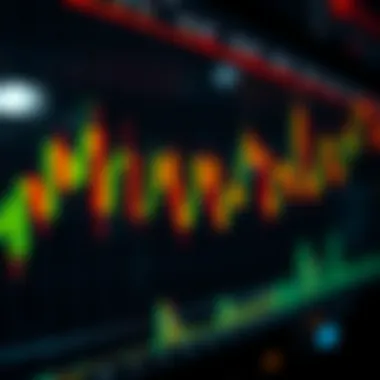Mastering Candlestick Charts for Trading Success


Intro
Navigating the intricate world of candlestick charts can be akin to trying to read a map without the legends. For anyone aiming to delve into cryptocurrency or financial markets, understanding these visual tools is crucial. Candlestick charts are more than just pretty pictures; they encapsulate vital market information, allowing traders to make informed decisions based on price movement, volume, and time.
At first glance, these charts may appear complex, with their array of colorful bars and patterns. Yet, underneath this veneer lies a straightforward system that can be deciphered with practice and insight. Our journey will focus not just on the aesthetics of the charts but also on their profound implications for trading strategies and market behavior.
By unpacking the elements that constitute candlestick charts, the significance of their patterns, and the methodologies for effective analysis, readers will develop a nuanced appreciation of how these tools can shape trading outcomes. This guide seeks to equip both novices and seasoned traders with the ability to leverage candlestick charts intelligently, honing their skills and enhancing their market strategies.
Prologue to Candlestick Charts
Candlestick charts play a vital role in deciphering the financial markets, especially among traders and investors. These charts are more than just a collection of colorful symbols; they serve as a visual language that communicates market sentiment and potential price movements. In the context of cryptocurrency and stock trading, the ability to read and interpret these charts can mark the difference between successful trades and costly mistakes.
Understanding candlestick charts equips you with tools for better decision-making. The benefit of analyzing these charts lies in their ability to condense price information into patterns that reveal investor psychology and market dynamics. Candlesticks can show, at a glance, the open, close, high, and low prices for a specific time period, highlighting whether the market sentiment is bullish or bearish.
In this section, we will delve into the rich history and fundamental structure of candlestick charts, paving the way for more complex analysis in later sections. By grasping the essence of these charts, traders can harness their potential to spot trading opportunities more effectively.
History and Origin
The development of candlestick charts can be traced back several centuries. Originating in Japan during the 17th century, these charts were employed by rice traders. They found that tracking price movements visually provided a clear understanding of market trends and buyer/seller behaviors. This approach to price representation eventually made its way to Western markets in the late 20th century, where it has since gained immense popularity across various trading platforms. The historical context underlines the importance of candlestick charts in financial analysis today.
Basic Structure of Candlesticks
The structure of candlesticks is fundamental to understanding their function in technical analysis. Essentially, each candlestick provides a snapshot of market activity for a designated time frame.
Open, High, Low, Close
The four primary components of a candlestick are its open, high, low, and close prices. When you see a candlestick, the open price indicates where the market started at the beginning of a time period. The high price represents the peak value during that period, while the low shows the lowest price. Finally, the close price marks the end of that period. This interplay between these four points helps traders gauge market dynamics without wading through excessive numbers.
These prices are particularly significant as they form the baseline for many trading strategies. For instance, a higher close relative to the open might suggest strong buying interest, while the reverse could indicate selling pressure. Ignoring these basic elements could lead to misunderstandings of market conditions.
Body and Wicks
A candlestick consists of a body and extensions known as wicks or shadows. The body represents the price range between the open and close. A filled body indicates a close lower than the open, suggesting bearish sentiment, while an empty or hollow body shows bullish sentiment with a higher close.
The wicks extend above and below the body, indicating the volatility of the asset's price during the chosen period. These components tell a deeper story about price action and can reveal critical insights regarding rejection levels—where buyers or sellers stepped in to push prices back in one direction or another. A long wick can mean that there was significant buying or selling pressure, which can help traders make more informed decisions about future trades.
The complexity of market trends is often distilled into candlestick patterns; however, it is important to consider not only individual candlesticks but also their context within broader market trends.
In summary, comprehending the structure and functioning of candlesticks offers insights that are critical for informed trading decisions. With this foundational knowledge, you can effectively interpret market movements and develop a keen eye for potential opportunities in the fast-paced world of trading.
The Significance of Candlestick Analysis
Candlestick analysis holds a pivotal role in the world of trading, especially in dynamic markets like cryptocurrency. It captures the essence of price movements in a visually engaging manner, which is crucial for traders looking to make informed decisions. By offering insights into market sentiment, candlestick patterns help traders identify potential buying and selling opportunities before they surface in traditional analysis. This section aims to unpack the significance of candlestick analysis, emphasizing its advantages and the considerations traders should keep in mind.
Interpretation of Market Sentiment
Candlestick charts are uniquely positioned to reflect market sentiment because they portray both the open and close prices along with the highs and lows of a specific trading period. This information provides a snapshot of buyer and seller activity. For instance, a long green candlestick often indicates strong buying pressure, suggesting bullish sentiment, while a long red candlestick points to selling pressure, highlighting bearish sentiment.
The greater the body of the candlestick, the more pronounced the sentiment, giving traders clues about potential market direction. A quick glance can often suffice to gauge prevailing emotions in the market—whether traders are feeling optimistic or pessimistic about price movements. By keeping an eye on momentum shifts conveyed through these candlesticks, individuals can anticipate price changes and adjust their strategies accordingly. In essence, understanding market sentiment can be the difference between a successful trade and a missed opportunity.
Comparison with Other Chart Types
Line Charts
Line charts serve as a basic way to visualize price movement over time. They plot the closing prices at regular intervals, connecting these values with a continuous line. One key characteristic of line charts is their simplicity; they strip away the noise of daily price variations, providing a straightforward view of price trends. This makes them a popular choice for beginners or for individuals who are looking to get a quick snapshot of market movements.
However, while line charts can effectively show overall trends, they lack the granularity offered by candlestick charts. For example, they do not show the opening price, highs, or lows within a given period, potentially omitting crucial context. This simplicity might be a double-edged sword—while it fosters clarity, it can also lead to missed signals in market volatility.
Bar Charts


Bar charts, on the other hand, present a more detailed view of price action. Each bar displays the open, high, low, and close prices, similar to candlesticks, but without the visual cues of color and body size. The key characteristic of bar charts is their ability to encapsulate day-to-day fluctuations more clearly than a line chart. They allow traders to grasp market dynamics over a specified period effectively.
Nonetheless, bar charts can be seen as less user-friendly compared to candlestick charts. The absence of color coding may require more time to process the information, especially for new traders. The unique feature of bar charts is that they reveal the entire price range during a period, which is crucial for understanding market volatility and potential reversals.
Ultimately, candlestick analysis stands out due to its ability to convey a wealth of information in an intuitive format that aligns closely with market psychology. The insights obtained from candlestick patterns can amplify traditional technical analysis approaches, offering a nuanced understanding of what’s really happening beneath the surface of price movements.
Key Candlestick Patterns
Candlestick patterns serve as vital indicators in the world of trading. Understanding these patterns can enhance your ability to read market sentiments, whether you're exploring cryptocurrencies or traditional financial markets. Key candlestick patterns can often signal changes in trend and give traders a sense of when to enter or exit trades. Recognizing these patterns is essential for making informed decisions and navigating market volatility with confidence.
Bullish Patterns
Hammer
The Hammer is a significant candle pattern that can indicate a potential reversal in a downtrend. This pattern appears when the market experiences a decline and then quickly recovers to close at or near the opening price. A key characteristic of the Hammer is its small body positioned near the top of the trading range, with a long lower wick that resembles a hammer's handle.
- Identifying Feature: For traders, the critical aspect of the Hammer is its ability to signal bullish sentiment after a period of selling pressure.
- Why It's Beneficial: It is often regarded as a strong indicator for potential price rebounds, making it a popular choice among traders looking for swing opportunities.
- Unique Advantage: The long lower shadow indicates that buyers have stepped in after sellers pushed the price lower, suggesting a shift in market dynamics. However, traders should keep in mind that confirmation is necessary, ideally by following the Hammer with a bullish candlestick.
Engulfing Pattern
The Engulfing Pattern is another important formation for traders, comprised of two candles where the second candle completely engulfs the first. When this pattern emerges in a downtrend, it can signal a potential reversal toward bullish sentiment. Conversely, an Engulfing Pattern during an uptrend can indicate a shift towards bearish momentum.
- Identifying Feature: The most compelling aspect of this pattern is its ability to illustrate a sudden increase in buying (or selling) pressure.
- Why It's Beneficial: Traders often find this pattern favorable, as it shows that momentum is so strong that it fully eclipses the previous candle's action.
- Unique Advantage: The Engulfing Pattern’s reliability can strengthen with larger candlestick bodies, reflecting a more decisive shift. However, it’s advised for traders to assess this pattern in the context of other indicators, as it can sometimes produce false signals.
Bearish Patterns
Shooting Star
The Shooting Star candlestick is known for identifying potential price reversals at market peaks. It forms when a considerable rally is followed by a candlestick that closes lower than its opening price but has a long upper wick. This dynamic can indicate that buyers pushed prices higher, but sellers ultimately regained control.
- Identifying Feature: A key characteristic of the Shooting Star is its long upper shadow paired with a small body at the lower end of the trading range.
- Why It's Beneficial: Traders appreciate this pattern as it suggests that bullish momentum may be waning, alerting to a possible shift in trend.
- Unique Consideration: The reliability of the Shooting Star increases when it appears after an extended upward movement. However, it’s essential to seek confirmation before taking action, as standalone signals can sometimes be misleading.
Dark Cloud Cover
The Dark Cloud Cover pattern is a bearish reversal indicator that typically unfolds after an upward price movement. This formation consists of a large bullish candle followed by a strong bearish candle that opens above the high of the preceding candle and closes below its midpoint.
- Identifying Feature: The primary aspect that defines the Dark Cloud Cover is its combination of bullish and bearish sentiment encapsulated in just two candles.
- Why It's Beneficial: This pattern is favorable for traders seeking to capitalize on potential downturns in price following clear upward trends, marking a shift in market psychology.
- Unique Advantage: The potency of this pattern increases with larger body sizes, indicating significant seller interest. Still, it’s crucial to confirm with subsequent candles to avoid rash decisions.
Reversal Patterns
Doji
The Doji candlestick holds particular importance as it indicates indecision among traders about the next price move. This pattern occurs when the opening and closing prices are nearly the same, producing a very small body with longer shadows.
- Identifying Feature: Its key characteristic is the ration of equal buying and selling pressures, represented by the thin body.
- Why It's Beneficial: The Doji can serve as an alert to potential reversals, signaling that the market may be at a turning point.
- Unique Feature: The versatility of the Doji allows it to form in various market conditions, enhancing its reliability. Traders should, however, look for further confirmation before making trades based on this pattern alone.
Tweezer Tops and Bottoms
Tweezer Tops and Bottoms are powerful reversal patterns characterized by two or more candlesticks that have matching highs or lows, forming a top or bottom, respectively. These patterns can indicate strong potential reversals in market trends when identified properly.
- Identifying Feature: The matching highs in a Tweezer Top signal that buyers are losing momentum, while matching lows in a Tweezer Bottom show that sellers are giving up ground.
- Why It's Beneficial: Traders often use this pattern as a way to identify entry points or to place stop-loss orders effectively.
- Unique Advantage: While this pattern's simplicity is appealing, confirmations are essential, particularly when trading volatile instruments, as market noise can often mask the underlying signal.
Remember, while candlestick patterns can significantly assist in understanding market movements, they should not be used in isolation. It is prudent to combine these patterns with other market analysis techniques for maximum effectiveness.
Understanding Market Trends
Understanding market trends is essential for any investor navigating the intricate landscapes of financial markets. Market trends reveal the general direction in which prices are moving, whether upwards, downwards, or sideways. This makes grasping market trends not just a preference but a necessity for those keen on making informed trading decisions. Recognizing these trends can significantly enhance one's approach, providing a clearer lens through which to view price movements and patterns in candlestick charts.
Identifying Trend Directions
To identify trend directions accurately, one must pay careful attention to the price behavior over time. An upward trend, or bull market, is characterized by consistently higher highs and higher lows. In contrast, a downward trend, or bear market, displays lower highs and lower lows. The sideways movement implies consolidation where price remains within a certain range without a discernible trend.


Key indicators for identifying trends include:
- Higher Highs and Higher Lows: Indicates an uptrend.
- Lower Highs and Lower Lows: Indicates a downtrend.
- Horizontal Trend Lines: Suggests a range-bound market.
Recognizing these patterns requires one to observe multiple candlestick formations to validate trends. For instance, spotting three consecutive bullish candles can indicate a strengthening uptrend, while three bearish candles could imply a continuing downtrend. Moreover, tools like support and resistance levels can bolster trend identification, helping traders define where prices are likely to reverse or continue.
Using Moving Averages with Candlesticks
Now, let's pivot to a critical tool that traders often pair with candlestick analysis: moving averages. Moving averages smooth out price action to help clarify the trend direction. When applied to candlestick charts, they can serve as both dynamic support and resistance levels.
Traders typically look at two types of moving averages: the Simple Moving Average (SMA) and the Exponential Moving Average (EMA). While SMA provides an average price over a selected period, EMA gives more weight to recent prices, making it more sensitive to price changes.
Using moving averages can enhance trading strategies significantly:
- When the price crosses above the moving average, it may indicate a buying opportunity.
- Conversely, when price falls below the moving average, it might signal a selling opportunity.
- Combining the moving average with candlestick patterns can amplify insights, such as using a bullish engulfing pattern above the moving average line to confirm a buying decision.
Both trend identification and moving averages play pivotal roles in a trader's toolkit, providing a comprehensive view of the market landscape. By integrating these elements, investors can develop well-rounded strategies that are grounded in tangible data rather than mere speculation.
Techniques for Effective Candlestick Analysis
Candlestick charts are powerful tools in the arsenal of an investor or trader. Mastering them is not merely about recognizing patterns; it involves understanding how to leverage certain techniques that enhance effective analysis. Approaching candlestick analysis with the right techniques can significantly improve decision-making processes when navigating the tumultuous waters of financial and cryptocurrency markets. This segment dives into how combining candlestick analysis with various indicators and incorporating volume analysis can enrich your trading strategy.
Combining Candlestick Analysis with Indicators
Indicators serve as an additional lens through which traders can scrutinize market behavior. They provide quantitative data that, when evaluated alongside candlestick formations, can result in a more informed trading approach.
Relative Strength Index (RSI)
The Relative Strength Index (RSI) measures the speed and change of price movements. It's a momentum oscillator, which means it gauges the momentum behind price changes. A key characteristic of RSI is its scale, which ranges from 0 to 100. Generally, a reading above 70 indicates overbought conditions, while a reading below 30 suggests oversold conditions. This makes RSI a favored choice for traders seeking to capitalize on price corrections.
RSI’s unique feature lies in its ability to highlight divergences between price action and momentum. For instance, if the price rises to new highs but RSI fails to follow suit, this may signal a weakening trend. Such clues are invaluable for traders who want to avoid false breakouts or engage effectively in reversion strategies. However, like all tools, RSI has its drawbacks—primarily, it can sometimes generate false signals during prolonged trends, leading to confusion among traders.
"Using RSI effectively requires not just understanding the number, but also interpreting its narrative within the context of market sentiment."
Bollinger Bands
Bollinger Bands, established by John Bollinger, consist of a middle band (a simple moving average) and two outer bands that represent price volatility. This indicator's primary role is to help traders assess whether an asset is overbought or oversold in relation to its recent price action. A hallmark of Bollinger Bands is their adaptability; they dynamically adjust to market conditions, expanding during periods of high volatility and contracting during low volatility.
The unique feature of Bollinger Bands is the squeeze—a phenomenon that occurs when the bands narrow, indicating potentially forthcoming volatility. When the price breaks above or below the bands, it can suggest the establishment of a new trend, thus giving traders a strategic entry point. However, one should tread carefully, as false breakouts do occur, so combining Bollinger Bands with other indicators, such as RSI, can provide a more nuanced perspective.
Incorporating Volume Analysis
Volume is often considered the lifeblood of any market. Rising or falling prices mean little without underlying volume information to validate these movements. When assessing candlestick patterns, incorporating volume analysis can illuminate the strength or weakness behind price changes. High volume on a bullish candlestick suggests strong buying interest, while high volume on a bearish candlestick indicates strong selling interest.
Traders often look for volume spikes that coincide with key candlestick patterns. For example, if a bullish engulfing pattern emerges on high volume, this can serve as a robust signal for a potential upward trend. Conversely, low volume accompanying a price increase may lead to skepticism about the sustainability of that rise.
Common Mistakes in Reading Candlestick Charts
Understanding candlestick charts is an art that goes beyond just recognizing patterns. It’s vital for traders to know not only how to read them, but also how to avoid common pitfalls that can lead to costly mistakes. Recognizing these common errors helps in honing analytical skills and building a more robust trading strategy. This section covers two significant mistakes that often catch traders off guard.
Over-reliance on Individual Patterns
One of the most frequent blunders seen among traders is the overemphasis on individual candlestick patterns. While specific formations like hammers or dojis can provide important signals, relying solely on them is like trying to bake a cake using only flour. Patterns should be viewed as part of the larger picture, contributing one ingredient to an entire recipe.
Individual patterns often lead to misinterpretation if they are not considered within the context of preceding price movements or the overall trend. For instance, a hammer appearing in a strong bearish trend may not indicate a reversal, but rather just a momentary pause in selling pressure. Hence, it’s essential to combine these patterns with additional indicators or broader market conditions for informed decision-making.
Some traders may just look for one or two patterns that they think always signal a buy or sell opportunity. This approach can be misleading. Proper analysis involves considering:
- Preceding trend and market sentiment
- Volume data corresponding to the pattern in question
- Timeframes used in charting, as shorter timeframes might present more noise than clarity


This is where the wisdom of market experience comes into play. Knowing when to trust a candlestick formation and appreciate its predictive power is crucial.
Neglecting Broader Market Context
Another critical error that traders frequently make is neglecting the broader market context when analyzing candlestick charts. Ignoring external factors can lead you down a shaky path, as market conditions often heavily influence price actions.
For example, understanding broader economic indicators, news events, or changes in market sentiment can shed light on why a candlestick pattern forms the way it does. A bullish engulfing pattern may appear promising, but if it occurs on the brink of a major economic downturn, its relevance changes dramatically.
Traders should always be mindful of:
- Upcoming economic reports (like employment data or GDP reports)
- Political events that could impact market stability
- Global market trends that might influence local prices
"Ignoring the bigger picture in trading is like trying to navigate a ship without knowing the weather. You might sail for a while, but eventually, the storm will find you."
Incorporating these aspects into your candlestick analysis can enhance your reading accuracy and form a foundation for better trading decisions. It’s clear that relying too much on isolated patterns or disregarding external influences can lead to errors in judgments, affecting overall trading success.
By understanding these mistakes, traders can navigate their approach to candlestick charts with greater wisdom, leading to more effective and sharper trading strategies.
Practical Applications of Candlestick Analysis
Candlestick analysis does not merely serve as an academic exercise; it finds roots deeply in practical trading applications. This approach aids traders in effectively navigating the complexities of financial markets, contributing significantly to strategy development. The importance of integrating candlestick charts into a trading framework cannot be overstated, as they provide essential insights into market sentiment and price action. Here, we will explore how well-crafted strategies, risk management techniques, and adaptations to specific market conditions can enhance trading effectiveness.
Crafting a Trading Strategy
Entry and Exit Points
Entry and exit points showcase a pivotal facet of trading strategies. Understanding the dynamics of selecting these points is essential in maximizing returns and minimizing losses. For instance, utilizing candlestick formations as signals can provide traders with opportunities to enter a position when momentum appears favorable. Traders often look for specific patterns that indicate a shift in market direction, such as engulfing patterns or hammers. This aspect is not just about timing the market; it reflects a trader's ability to execute decisions based on visual market signals.
The main characteristic of entry and exit points consists of their timing and execution precision. It establishes itself as a popular choice among traders because it directly correlates with the potential for profit. When traders effectively interpret the signals provided by candlesticks, they can better gauge when to hop on a rising trend and when to jump off before a downturn.
However, there's a unique feature to consider: market volatility. It can impact the reliability of these points, making it a double-edged sword. In high volatility scenarios, signals may appear that don't hold up, which might contribute to false entries or exits. Thus, while entry and exit point analysis can significantly benefit a trading strategy, traders must exercise caution and pair this with broader market analysis to mitigate risks.
Risk Management
Risk management is another vital component when engaging in candlestick analysis. It's about placing safeguards around investments to minimize adverse effects rather than chasing profits alone. This strategy is especially crucial in volatile markets, where price swings can be dramatic. A well-defined risk management plan safeguards not only capital but also emotional well-being amidst turbulent conditions.
A critical feature of risk management lies in position sizing. It forces traders to evaluate how much of their portfolio should be risked on a particular trade, aligning this with their risk tolerance. A commonly adopted principle is risking no more than 1-2% of one's trading capital on each position. This approach repeatedly emphasizes preservation of capital, allowing for sustained trading engagement over the long haul.
Still, the interaction of candlesticks with market conditions should not be ignorable. For instance, a sudden market crash can render even the best risk management strategies ineffective if one is not cautious. Thus, continually revisiting and adapting risk management techniques, based on changing market dynamics and candlestick signals, can enhance a trader's resilience and overall profitability.
Adapting to Cryptocurrency Markets
In recent years, cryptocurrency markets have garnered attention, not solely for their growth potential but also their inherent volatility. Adapting candlestick analysis to these markets requires understanding their unique characteristics. Market sentiment can shift rapidly, and this unpredictability influences how candlestick signals should be interpreted.
For example, patterns that may have indicated a bullish reversal in a stable market might act differently in the dynamic cryptocurrency environment. Consider incorporating indicators like the Relative Strength Index for added context. This additional layer of understanding equips traders to interpret volatility more effectively.
Moreover, staying informed through reputable sources—like CoinMarketCap or Investopedia—can set traders apart in their analysis. Keeping up with live market trends and utilizing candlestick patterns tailored to these movements helps in crafting strategies that not only address entry and exit points but also incorporate prudent risk management.
Through careful application of candlestick analysis in various contexts, traders can optimize their strategies and respond proactively to the ever-evolving landscape of finance.
End
Candlestick charts serve as a cornerstone in the realm of financial analysis and trading strategies, especially in today’s volatile markets. The understanding of their structure and behavior enables traders to decode market movements and predict future trends with greater accuracy. By navigating through the intricacies of candlestick patterns, one can develop a nuanced comprehension of market sentiment—a crucial skill for any serious investor.
Significantly, this article has laid out how the combination of candlestick analysis with traditional indicators and modern tools enhances trading decision-making. From recognizing common patterns such as hammers or shooting stars to employing more complex strategies involving volume analysis, every technique discussed offers tangible benefits for traders.
Moreover, it’s essential for readers to grasp that the intersection of candlestick patterns with overall market conditions isn't merely academic; it’s a practical necessity. Ignoring the broader context undermines the effectiveness of candlestick signals, as they only reflect a moment in time. This is particularly relevant in the cryptocurrency market, where trends can shift seemingly overnight due to external events or news.
To distill the essence of what we've explored, here are some key takeaways:
- Importance of Patterns: Mastery of candlestick patterns can provide an edge in discerning potential market reversals and continuations.
- Strategic Integration: Candlestick analysis should be part of a broader trading strategy, incorporating other tools and indicators to confirm signals.
- Adaptability: Adapting to the rapidly changing landscape of financial markets, particularly in crypto, is crucial for capitalizing on fleeting opportunities.
In the world of trading, knowledge is power—and effectively reading candlestick charts is an invaluable skill in the investor’s toolkit. It opens doors to make informed decisions, ultimately guiding traders towards achieving their financial goals with heightened confidence and reduced risk.
"The secret to mastering the market lies in understanding its whispers through candlesticks."
Investors keen on devising their trading strategy should embrace these insights. Recognizing the time frames and contexts of candlestick signals will equip them to ride the waves of market fluctuations, rather than being swept away by them.







